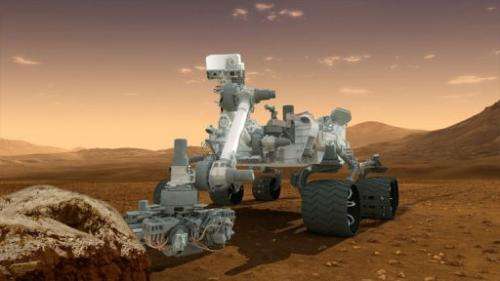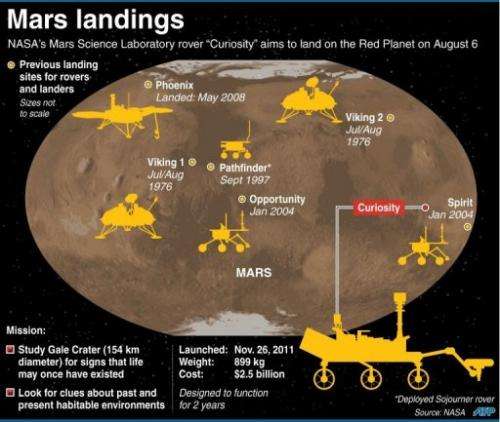NASA confident ahead of nail-biter Mars landing

NASA said Thursday all was well ahead of its nail-biting mission to Mars, with its most advanced robotic rover poised to hunt for clues about past life and water on Earth's nearest planetary neighbor.
On a two-year journey to seek out signs of environments that once sustained life, the landing of the Mars Science Laboratory and the largest and most sophisticated rover ever built, Curiosity, is set for 1:31 am August 6 (0531 GMT).
"The mission is going extremely well," said Pete Theisinger, director of the Engineering and Science Directorate at NASA's Jet Propulsion Laboratory in Pasadena, California.
"Everything is really on track... so we are really good to go three days out."
If all continues to go well, the unmanned rover will touch down in Gale Crater, one of the lowest points on Mars, where scientists believe the waters of ancient rivers flowing downhill once pooled.
The crater also contains a mountain that rises higher than any in the 48 continental US states, and should provide loads of information about the past through its sedimentary layers.
"When we do (land), we will have started an era of a whole new dimension of space exploration on the surface of another planet, and this is the dimension of deep time," said John Grotzinger, project scientist for the Mars Science Laboratory.
Describing Mars as a "planet that is kind of like our cousin," Grotzinger said he was hopeful that many questions would be answered on the mission, including how the once wet planet became so dry.
The mountain, Mount Sharp, is near Mars' equator and may hold as much as a billion years of history in its layers, dating back some three to four billion years ago "when the planet may have been more like Earth," he told reporters.
"We've got some cool geology to do ahead of us."
A complicated rocket-powered sky crane maneuver to lower the one-ton (900-kilo) vehicle onto the surface will be tested in real conditions for the first time.

Doug McCuistion, director of NASA's Mars Exploration Program, said the team would do its best to "stick the landing."
"This is a pretty amazing feat getting ready to happen," he said.
Approaching Mars' atmosphere at a speed of about 13,200 miles per hour, or 5,900 meters per second, the spacecraft must separate, a supersonic parachute must deploy, then a rocket-powered sky crane must activate to power the vehicle closer to the surface before lowering it with nylon tethers.
"It looks a little bit crazy," Adam Steltzner, chief engineer at JPL, said as he described the final moments before touchdown, which NASA has detailed in a video called "Seven Minutes of Terror."
"I promise you, it is the least crazy of the methods you could use to land a rover the size of Curiosity on Mars," Steltzner told reporters, adding that using airbags or trying a platform landing were ruled out.
"We have become quite fond of it and we are fairly confident that Sunday night will be a good night for us."
One key concern is the single parachute on board, he added. Most human jumpers would carry a backup, but carrying two 100-pound parachutes was not possible for this mission.
It may be 15-20 minutes after the landing itself until NASA knows exactly what happened to its rover, which is twice the size of its vehicles Spirit and Opportunity. They launched in 2004 and landed with the help of airbags.
Scientists are also monitoring the weather on Mars and will give an update on Saturday. Generally, this is a cold time of year on the Red Planet, with lots of water-ice clouds, but the potential for dust storms remains a concern.
The mobile toolkit on the rover is expected to begin its work within weeks of the landing, but one instrument for detecting radiation has already been collecting data for 221 days that could inform a future human exploration mission to Mars.
"Our observations already are being used in planning for human missions," said Don Hassler of Southwest Research Institute in Boulder, Colorado, principal investigator for Curiosity's Radiation Assessment Detector (RAD).
There were five radiation spikes from solar flares in that period, since the $2.5 billion project launched in late November 2011, an amount that NASA said would make a "significant contribution to a NASA astronaut's career-limit radiation dose."
(c) 2012 AFP





















